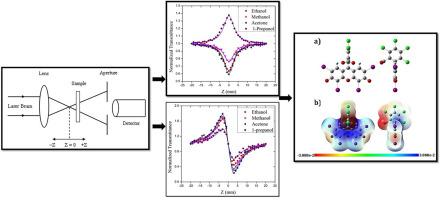极性质子和非质子溶剂诱导的杂蒽染料非线性光学和光学限制性质的DFT研究
IF 4.3
Q2 CHEMISTRY, PHYSICAL
引用次数: 0
摘要
Rose Bengal (RB)是一种杂蒽染料,在极性质子和非质子溶剂(包括乙醇、甲醇、1-丙醇和丙酮)中均表现出优异的非线性光学(NLO)性能。结果表明,RB染料表现出饱和吸收和反饱和吸收特性,分别为负吸收和正吸收。发现RB染料的三级NLO敏感性(χ3)为10⁻26 esu。此外,染料在各种溶剂中表现出10 - 5 K -⁻¹的热光学系数。当采用能量扩散光限制器时,RB染料在丙酮中表现出非常低的光限制阈值,为1.98 × 10²W/cm²。我们进行了多元线性回归分析来研究溶质-溶剂的相互作用,发现溶剂的极化率显著影响NLO的性质,其次是溶剂的其他光谱特征。利用密度泛函理论(DFT)在B3LYP/lanl2dz理论水平上进一步探讨了RB染料的NLO性能。主要NLO参数包括线性极化率(α)、一阶超极化率(β)和二阶超极化率(γ),在不同溶剂环境下进行了评价。计算结果表明溶剂对NLO反应有明显的增强作用。这些理论预测得到了实验观察的支持,证实了染料NLO行为的溶剂依赖性调制。本文章由计算机程序翻译,如有差异,请以英文原文为准。

Polar protic and aprotic solvents induced nonlinear optical and optical limiting properties of Xanthene dye: A DFT Study
Rose Bengal (RB), a xanthene dye, exhibits exceptional nonlinear optical (NLO) properties in both polar protic and aprotic solvents, including ethanol, methanol, 1-propanol, and acetone. The results indicate that the RB dye displayed both saturable and reverse saturable absorption characteristics due to negative and positive absorption, respectively. The third-order NLO susceptibility (χ3) of the RB dye is found to be the order of 10⁻⁶ esu. Additionally, the dye shows a notable thermo-optic coefficient of 10⁻⁵ K⁻¹ across various solvents. The RB dye exhibited an exceptionally low optical limiting threshold of 1.98 × 10² W/cm² in acetone when employed energy-spread optical limiters. We performed a multilinear regression analysis to investigate the solute-solvent interactions, revealing that the polarizability of the solvents significantly influenced the NLO properties, followed by other spectral features of the solvent. The NLO properties of RB dye were further explored using Density Functional Theory (DFT) calculations at the B3LYP/lanl2dz level of theory. Key NLO parameters, including linear polarizability (α), first-order hyperpolarizability (β), and second-order hyperpolarizability (γ), were evaluated in various solvent environments. The computational results highlight a clear solvent effect on the enhancement of NLO responses. These theoretical predictions are supported by experimental observations, confirming the solvent-dependent modulation of the dye’s NLO behavior.
求助全文
通过发布文献求助,成功后即可免费获取论文全文。
去求助
来源期刊

Chemical Physics Impact
Materials Science-Materials Science (miscellaneous)
CiteScore
2.60
自引率
0.00%
发文量
65
审稿时长
46 days
 求助内容:
求助内容: 应助结果提醒方式:
应助结果提醒方式:


